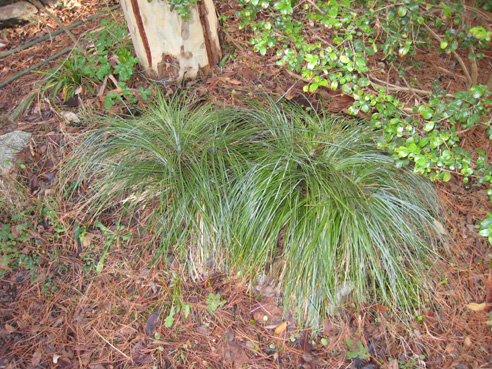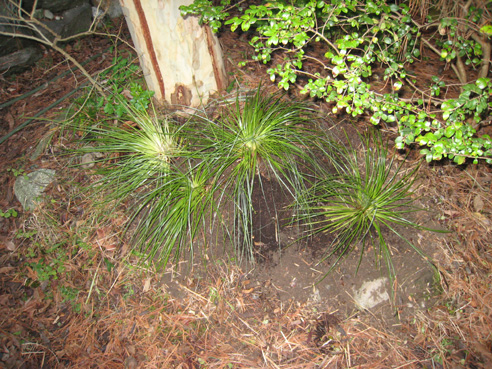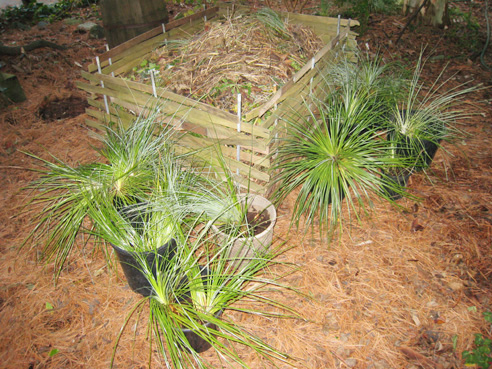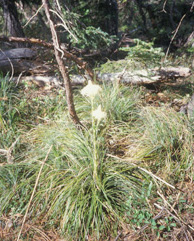Plant of the Month: February 2008
|
| Beargrass |
Xerophyllum tenax (Pursh) Nutt.
|
MELANTHIACEÆ (LILIACEÆ s.l.); Melanthium Family
|
| Sometime in the 1980s my sister gave me a few beargrass clumps. Employed at a nursery, she plucked them from the root-balls of wild-collected alpine firs or mountain hemlocks. In my Seattle garden, the beargrass clumps thrived, growing into luxurious mounds of glossy, dark green foliage, admired by many visitors. The leaves are grassy, long and slender, sharp edged and very tough. The generic name Xerophyllum comes from the Greek xeros (dry) and phyllon (a leaf). The 1814 specific name tenax means tough or tenacious. |
| The genus Xerophyllum consists of only two species. Besides beargrass, the other species is Xerophyllum asphodeloides, the Turkey's-beard, native to pine barrens of the eastern United States. Other names for beargrass include Indian Basket-Grass, Squaw Grass, Elk Grass, Soap Grass, Pine Lily and Fire Lily. |
| It grows from SE British Columbia into to Rockies of Montana, to central California. mostly on dry ridges and mountain sides, though a bit makes it to near sea level. It is a common, distinctive, well known plant to mountain hikers. |
| In cultivation, beargrass has been more sought and attempted than achieved and enjoyed, and has been far more leafy than floriferous. Having watched it in my garden for at least 16 years, and recalling only two or three years therein when it deigned to bloom, I attest to its shy flowering, but also assert that even were it never to bloom, its foliage alone is lovely. It forms a dense evergreen mound of fine beauty. It neither needs watering, nor is hurt by it. It grows in sun or shade. When it does bloom I feel like I won the lottery. |
| Reading about beargrass, I learned that seedlings can require 10 to 12 years before blooming. Also, that many nursery seedlings die soon after being planted. Division, or transplants, bloom sooner. Every time a flower stem blooms, and sets seeds, it dies --but at its base are smaller offset plants that will bloom in another 5 years or so. Forest fires, logging, or other major changes also induce exceptional years of bloom. As such, it has been suggested that gardeners burn their plants to see if that jolts them into blooming. |
| People desire flowers because they are lovely and fragrant. The flowerstems ascend and bloom anytime from May into August, depending on the plant's location and the year. The flowers are white or creamy-white, and the stem elongates as the flowers fade and turn into seed capsules. The whole stem length can be anywhere from 18 inches to 6 feet. The stem is leafy, terminated by the plump floral cluster of 6 to 18 inches. |
| Native Americans used dried beargrass leaves extensively to weave water-tight baskets, hats, pouches, cups, and garments. They often dyed the leaves --red alder bark gave red color; Oregon grape root yielded yellow. The leaves can be 3 feet long, and at the very base measure up to half an inch wide, tapering gradually to a needle-like tip, and edged the whole length with sharp tiny teeth. |
| The name beargrass is explained in Western Wild Flowers and Their Stories, by Charles Francis Saunders, 1933: "The reason for this name [bear grass], while easy to guess at, has not been so easy to make sure of. My quest for it eventually took me to Mr. Leslie L. Haskin [1882 - 1949], of Brownsville, Oregon, an industrious student of native plants. He was given the following explanation by an experienced trapper and woodsman: In the spring, when the bears first come out of their winter sleep, it seems they seek the higher sunny ridges where the snow has melted away and the bear-grass grows, and digging up the tuberous rootstock they eat them with apparent relish. The same woodsman further said that the roots boiled and the water evaporated make an excellent soap, which would account for the name soap-grass. Roasting dissipates the saponaceous quality and renders the root edible, at least to Indians." |
| Haskin's Wild Flowers of the Pacific Coast (1967 edition) states: "The name elk grass, also often given it, is less clear, but since squirrels and chipmunks cut down the fresh flower stalks and eat them, it is equally to be supposed that elk may relish them. The name squaw-grass comes, of course, from its use in basketry, but its truly aboriginal name, current among the Indians of the Columbia Rapids where a large trade in the prepared leaves was carried on, was quip-quip." |
| In late December I divided my beargrass clumps for the first time. The pictures below show the results. I learned afterward that I should have done this job when the plants were actively growing; not in winter. Oh, well. I will let you know what happens. My goals were to see if this shocking treatment would induce bloom, and to give away surplus plants to some other Seattle gardeners. (ALL my transplants died!) |
| That animals eat beargrass is well known. That Indians sometimes roasted or boiled the stout rootstock to eat is also reported. But I have not read anywhere, nor heard say, that anyone other than myself has tasted the immature flowerstems. Noticing that snails in my garden munched on the stems, just like they do on asparagus, I thought, "why not? It is not known to be poisonous." So I tasted the stems, raw, and found the flavor and texture agreeable. |
| On July 3rd 1999 I gathered fully 30 wild plant species for a salad in the Cedar Basin area of Red Butte Wilderness in the Siskiyou Mountains of extreme northern California. One of my ingredients was the fresh shoots of beargrass. |
So, beargrass affords 1) pretty foliage 2) pretty flowers --rarely 3) foliage for weavers or florists 4) edible young stems for the daring . . .
Back |

Beargrass before dividing (photo by ALJ)
|

Beargrass after dividing (photo by ALJ)
|

surplus Beargrass in pots (photo by ALJ)
|

wild Beargrass in bloom (photo by ALJ)
|
|
|

